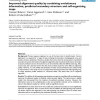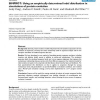330 search results - page 65 / 66 » Phylogenetic trees in ACL2 |
BMCBI
2006
13 years 7 months ago
2006
Background: Since the publication of the first draft of the human genome in 2000, bioinformatic data have been accumulating at an overwhelming pace. Currently, more than 3 million...
BMCBI
2006
13 years 7 months ago
2006
Background: Protein sequence alignment is one of the basic tools in bioinformatics. Correct alignments are required for a range of tasks including the derivation of phylogenetic t...
JCB
2006
13 years 7 months ago
2006
Biological signaling networks comprise the chemical processes by which cells detect and respond to changes in their environment. Such networks have been implicated in the regulati...
BMCBI
2005
13 years 7 months ago
2005
Background: The chemical property and biological function of a protein is a direct consequence of its primary structure. Several algorithms have been developed which determine ali...
BMCBI
2005
13 years 7 months ago
2005
Background: General protein evolution models help determine the baseline expectations for the evolution of sequences, and they have been extensively useful in sequence analysis an...


